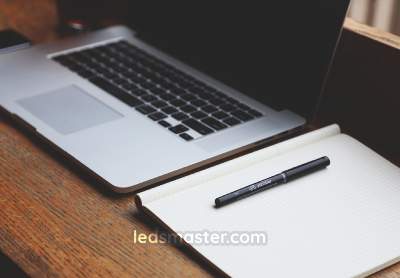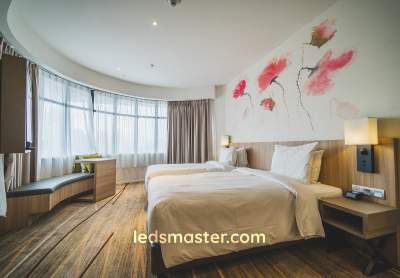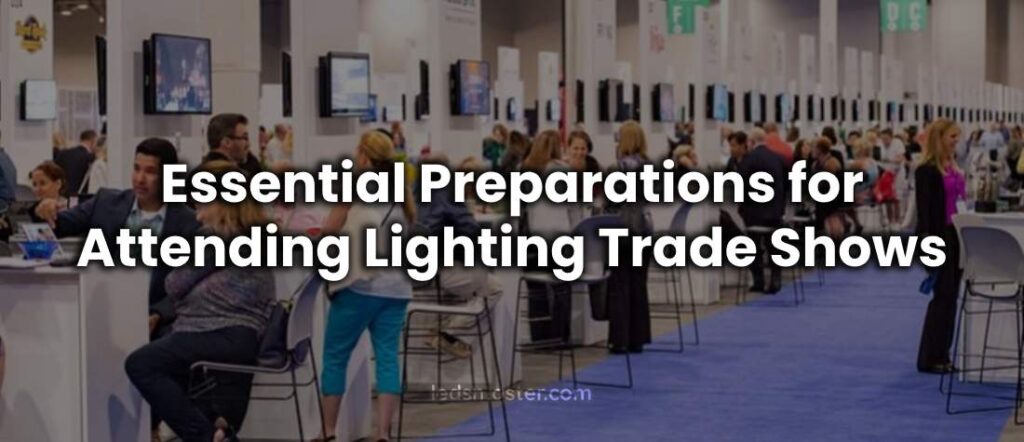Lighting trade shows, hosted by leading vendors, industry leaders, and accredited associations, offer a wealth of opportunities for both buyers and sellers. These events serve as a hub for discovering cutting-edge technologies, networking with global experts, and deepening your knowledge of the latest and upcoming innovations. For potential buyers, trade shows provide a chance to witness live demonstrations, compare various products, and make well-informed purchasing decisions. Exhibitors, eager to secure on-the-spot contracts, often present enticing deals and bargains.
Given the significant advantages of attending these trade shows, proper preparation is crucial. Arriving without a well-thought-out plan can result in an unproductive day. With the vast scope of lighting trade shows, it’s nearly impossible to visit every booth or attend every seminar. Thus, being selective and strategic in your approach is essential.
A common question we receive from attendees is: “What should I prepare before going to a lighting trade show?”
In this guide, we will outline the nine key preparations you should make before heading to a lighting trade show to ensure a successful and productive experience.
Table of Contents
ToggleEssential Preparations for Attending a Lighting Trade Show
Pre-Register for the Show
 Pre-registering for a lighting trade show is a critical step to ensure a seamless and productive experience. Many trade shows, especially those organized by influential brands or industry leaders, require pre-registration and often offer ticketed entry. These events can attract a large number of attendees, and tickets may sell out quickly due to high demand. Therefore, securing your registration early is essential to avoid missing out on the opportunity to participate. Typically, tickets and registration for these shows are available through official websites or partner platforms associated with the event.
Pre-registering for a lighting trade show is a critical step to ensure a seamless and productive experience. Many trade shows, especially those organized by influential brands or industry leaders, require pre-registration and often offer ticketed entry. These events can attract a large number of attendees, and tickets may sell out quickly due to high demand. Therefore, securing your registration early is essential to avoid missing out on the opportunity to participate. Typically, tickets and registration for these shows are available through official websites or partner platforms associated with the event.
To pre-register, visit the trade show’s official website or the designated ticketing partner. Follow the instructions provided to complete your registration, which may include filling out personal information, selecting ticket types, and making payments. After completing the registration process, you should receive a confirmation email with your ticket details and any additional information needed for the event. Keep this confirmation handy, either as a printed copy or on your mobile device, as it may be required for entry. By pre-registering, you also gain access to any exclusive content or early-bird opportunities that may be available to registered attendees.
Enter with a Smart Sheet
Navigating a lighting trade show effectively requires careful planning and organization. With the vast array of exhibitors and events, it can be overwhelming to decide where to focus your attention. To make the most of your visit, begin by reviewing the list of exhibitors and identifying the ones that align with your interests and needs. Create a prioritized list of these brands and products, and develop a detailed schedule for your day.
A smart sheet or a well-organized itinerary will be your best tool in this process. Include specific times for visiting each booth, attending key seminars, and participating in networking sessions. This approach ensures that you cover all the essential areas and don’t miss out on valuable opportunities. It’s also helpful to note the locations of different exhibitors on a map of the venue, which can aid in navigating the event efficiently. By sticking to your planned schedule, you can maximize your time and ensure that you meet all your objectives for the trade show.
Make Appointments
During a trade show, the opportunity to meet with industry experts, influencers, and bloggers can be invaluable. However, these key individuals often have busy schedules, and without prior arrangements, you might find yourself waiting in long lines or missing out on important conversations. To avoid this, make appointments with these contacts well in advance of the event.
Reach out to the individuals or their representatives before the trade show to schedule a specific time to meet. This could involve emailing them directly, using the trade show’s networking platform, or contacting their offices. Clearly state your intentions for the meeting and propose a few time slots that work for you. Confirm the meeting details and make a note of them in your itinerary. Similarly, for seminars, workshops, or networking events, pre-registering ensures you have reserved your spot and can participate without any last-minute issues. By planning these appointments ahead of time, you’ll be able to engage in meaningful discussions and make the most of the trade show experience.
Book Your Air Tickets and Get Your Visa Sorted in Advance
Travel logistics play a crucial role in your trade show preparation. To avoid last-minute stress and potentially higher costs, it’s advisable to book your air tickets well in advance. Aim to secure your flights at least a month before the event. Early booking not only helps in finding better rates but also ensures that you get your preferred travel times and seats.
If you’re traveling internationally for the trade show, ensure that your visa application is submitted as early as possible. Visa processing times can vary, and applying well in advance gives you ample time to handle any issues that may arise. While you can apply for a visa independently, utilizing a professional visa service can simplify the process and provide additional support in case of complications. Additionally, verify that your passport is valid for at least six months beyond your intended travel dates to avoid any entry issues.
Book Your Accommodation
 Securing accommodation is another vital aspect of your trade show preparation. As the event date approaches, hotels and other lodging options near the trade show venue can become scarce, and prices may increase significantly. To ensure you get a convenient and reasonably priced place to stay, book your accommodation well in advance.
Securing accommodation is another vital aspect of your trade show preparation. As the event date approaches, hotels and other lodging options near the trade show venue can become scarce, and prices may increase significantly. To ensure you get a convenient and reasonably priced place to stay, book your accommodation well in advance.
Start by researching hotels or other lodging options close to the trade show venue. Consider factors such as proximity to the event, transportation options, and amenities offered. Many brands and exhibitors book accommodations for their representatives months ahead of time, so acting early will give you access to a wider range of choices and better rates. Once you’ve selected your accommodation, make your reservation and keep a confirmation record. This early planning helps you avoid last-minute inconveniences and ensures a more comfortable and stress-free stay during the trade show.
Arrange for a Pick-up and Drop
The logistics of getting to and from a trade show can be complex, especially in bustling cities where large events like lighting trade shows are held. During such events, the demand for transportation services often exceeds availability, particularly during peak hours or if you arrive at unconventional times. To mitigate the stress of scrambling for a taxi or navigating unfamiliar public transport systems, it’s wise to arrange for a pick-up and drop-off service in advance.
Start by researching transportation options that cater to trade show attendees. Many trade shows offer shuttle services or have partnerships with local transportation providers. Check the event’s official website or contact their customer service for recommendations on reliable services. If these options are unavailable or do not meet your needs, consider booking a private car service or ride-sharing service. Pre-booking a car service guarantees you have a reserved vehicle, reducing the uncertainty of finding transportation at the last minute.
When arranging your pick-up and drop-off, provide detailed information about your flight or travel schedule to the service provider. This includes your arrival and departure times, flight numbers, and any special instructions for navigating the airport or venue. Confirm the booking and keep contact details for the driver or service provider handy. This preparation ensures a smooth and hassle-free transit experience, allowing you to focus on making the most of the trade show.
Carry a Lux Meter
For those looking to make informed decisions about lighting purchases, carrying a lux meter is essential. A lux meter measures the intensity of light in a given area, providing a quantifiable metric of brightness that can be crucial when evaluating different lighting options. Given that lighting trade shows often feature a variety of lighting products with differing levels of brightness and intensity, having a lux meter allows you to make objective comparisons.
When selecting a lux meter, opt for a portable model with data logging capabilities and a measurement accuracy of around 3%. This level of accuracy ensures reliable readings, allowing you to assess and compare the performance of various lighting products. The data logging feature can record measurements over time, providing a more comprehensive understanding of how different lights perform under varying conditions.
Bring your lux meter to the trade show and use it to measure the brightness of the lights you’re interested in. Since some lighting products, especially high-intensity floodlights, can be overwhelming to the eyes, a lux meter helps you avoid subjective impressions and make decisions based on concrete data. This tool will be invaluable in ensuring that your lighting choices meet your specific needs and preferences.
A High FPS Camera Is Another Must
Flicker in lighting is often subtle and difficult to detect with the naked eye, but it can significantly impact the quality of light and visual comfort. To address this, a high FPS (frames per second) camera can be a valuable tool for identifying flicker in lighting products. Flicker occurs when the light output fluctuates rapidly, which can be especially problematic for LED lights and other modern lighting technologies.
When selecting a high FPS camera, look for one with a high frame rate, ideally 240 fps or higher. This allows you to capture rapid changes in light output that may not be visible during normal observation. If you don’t have access to a professional camera, many smartphones come equipped with slow-motion camera features that can also be effective in detecting flicker. Ensure that your camera is set to record at a high frame rate to capture detailed footage of the lighting products.
Use the camera to record and review the lighting options at the trade show. By analyzing the footage, you can assess the flicker rate and determine whether the lighting products meet your quality standards. This approach helps you avoid purchasing lights with undesirable flicker issues, ensuring that your final selections provide consistent and comfortable illumination.
Do Not Forget to Fit in a Pair of Anti-Glare Glasses in Your Backpack
At a lighting trade show, you will encounter a wide range of lighting sources, including those with intense glare or reflective surfaces. To protect your eyes and maintain clear vision, it’s important to carry a pair of anti-glare glasses. These glasses feature a reflective coating that minimizes glare and reduces eye strain, making it easier to view and evaluate lighting products.
When selecting anti-glare glasses, choose a pair that offers effective protection against both direct and reflected light. The coating on the lenses should reduce glare from various light sources, including spotlights, backlit displays, and reflective surfaces. By wearing these glasses, you can comfortably navigate the trade show floor and view the lighting products without being hindered by excessive glare.
Pack the anti-glare glasses in your backpack or carry bag, ensuring they are readily accessible during your visit. This simple yet effective tool will enhance your experience at the trade show, allowing you to make better-informed decisions and evaluate lighting options with greater clarity.
Bonus Tip: Carry Some Cash
A practical tip for maximizing your trade show experience is to carry some cash. Many exhibitors offer significant discounts on large or bulky lighting fixtures towards the end of the event. This practice helps them avoid the logistical challenges and costs associated with shipping unsold items back to their warehouses.
Having cash on hand can be advantageous when negotiating deals and making purchases. If you are adept at haggling, you may be able to secure these items at a much lower price than their original retail value. Look for opportunities to purchase discounted products as the trade show concludes, and be prepared to negotiate effectively. Carrying cash ensures that you are ready to take advantage of these deals and make the most of your trade show experience.
Conclusion
Attending a lighting trade show offers a unique chance to explore the latest innovations and connect with industry experts. To make the most of your visit, ensure you pre-register early, plan your schedule with a smart sheet, and arrange appointments with key contacts. Book your travel and accommodation in advance, and consider practical tools like a lux meter and high FPS camera for informed decisions. Don’t forget anti-glare glasses for comfort and carry cash for potential discounts. Proper preparation will help you navigate the event effectively and maximize your trade show experience.

